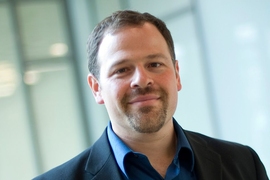A longtime journalist and science writer, Seth Mnookin is a professor of science writing, director of the Graduate Program in Science Writing, and director of the MIT Communications Forum. In his most recent book, "The Panic Virus: The True Story Behind the Vaccine-Autism Controversy," which won the Science in Society Award, Mnookin tackles a fundamental question: How do we decide what the truth is? SHASS Communications spoke with Mnookin recently about the state of journalism in an era when public trust is threatened by cries of "fake news" from political partisans aiming to discredit unflattering stories and to diminish the efficacy of the free press.
Q: Your most recent book, "The Panic Virus," examines what happened when science journalists led the public astray on the issue of vaccinations. What changes have there been in the way the issue has been reported since the book was published?
A: In the nine months before my book came out in early 2011, the fraudulent 1998 study that launched the unfounded fears that the measles-mumps-rubella vaccine was linked to autism was retracted and the lead author lost his medical license. Those factors, along with my book, the work by other journalists, and the countless studies that showed there was no link between the MMR vaccine and autism helped put an end to the “on the one hand, on the other hand” reporting that had plagued so much of the journalism on the issue for so long.
Since then we’ve seen the issue occasionally creep back into the news — typically when a politician (Michelle Bachman in late 2011, Donald Trump more recently) makes an outrageous and inaccurate claim at a debate or press conference — but for the most part, reporting on this topic has been much improved.
Q: Some have called the current media climate “postfactual.” Have you observed any changes, for better or worse, in the coverage of other major scientific topics, such as climate change, health care, or energy policy?
A: American journalism is based on the principle of objectivity: journalists are supposed to be dispassionate about the subjects they cover. We’ve seen too many journalists confuse not taking sides with not calling out liars and frauds or giving too much credence to fringe or extreme views. HBO's John Oliver illustrated the fundamental dishonesty of presenting “both sides” of settled issues as having equal weight when he had a segment that featured one climate change denier and 100 scientists who all agreed that human activity was contributing to dramatic changes in the environment.
It’s crucial for journalists to remember that even reporting that something is false will lead to a certain percentage of people believing that it’s actually true. One of the most important lessons I teach my students is sometimes, the best way to cover a controversy is not to cover it at all.
Q: Why is it so important that the public be informed about current research findings? Since sharing factual data does not, alas, always change strongly-felt but erroneous views, what additional approaches do you think can work to help the general public and leaders make data-based decisions?
A: I always get concerned when journalists start talking about using tactics to get politicians or the public to act in a certain way, regardless of how commendable or virtuous that behavior would be. The media’s responsibility is to report things fairly, accurately, and comprehensively. I think it is the responsibility of our elected and nonelected leaders to support the truth.
Unfortunately, the current administration has done almost the exact opposite. I do think that there is an enormous opportunity at the moment for scientists to become public advocates and ambassadors. President Reif has done that consistently and eloquently, as have other MIT scientists, including people like Eric Lander at the Broad Institute.
Q: As President Reif has said, solving the great challenges of our time will require multidisciplinary problem-solving — bringing together expertise and ideas from the humanities, arts, social science, and STEM fields. Can you share why you believe it’s important in such global problem-solving to incorporate research and insights from the humanities fields? What challenges do you see to such collaborations — and how can we overcome them?
A: As we’ve seen in areas like climate change and the vaccine-autism debate, having mountains of scientific research supporting a single conclusion is not enough in and of itself to spark widespread public acceptance. Tackling these challenges, like many other global issues, will require messengers who can communicate what the problems are and why the general public should care. Academia is often structured and incentivized in a way that discourages collaborations outside of one’s own field. Creating opportunities for those within STEM fields and the humanities to work together is one way to begin overcoming that obstacle.
Q: What are the biggest challenges the MIT Graduate Program in Science Writing faces in the future?
A: GPSW students are trained to be fair in their reporting and to accurately inform the public. Doing this requires overcoming significant obstacles within the media industry. Changes in the industry’s financial structure have meant that there are fewer staff opportunities for dedicated science reporters than ever before and freelancers are struggling with lower pay and larger workloads. Aspiring writers and journalists who decide to focus on science are already making enormous sacrifices. Our biggest challenge right now is to find a way to fully fund our students, so that they can embark on their careers without any debt.









